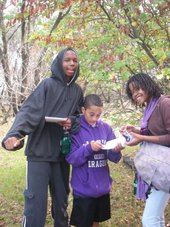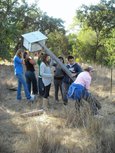Highlight
Collaborations in Restoring Farmland
Achievement/Results
A unique collaboration between environmental organizations, high school classes, local landowners, and university researchers is changing the face of environmental restoration and land use in rural northern California. University of California Davis graduate student and NSF-funded IGERT trainee Tawny Mata has been instrumental in enhancing the participation of the university community in this effort, with substantial support from other UC Davis IGERT personnel.
In the Biological Invasions IGERT, a 2005-2006 cohort of trainees worked with the Center for Land-based Learning, a 501(3)© organization, to create a high school environmental science curriculum that included a particular focus on invasive species. That curriculum now is being used by the Center for Land-based Learning in its work with urban and rural high school teachers through its Student and Landowner Education and Watershed Stewardship program (SLEWS).
The SLEWS program is a partnership between the Center for Land-Based Learning, local schools, and local environmental non-profit organizations that make connections with landowners, and uses private and public lands for restoration projects. Students from urban, rural, and suburban high schools in the Sacramento region visit these sites and apply classroom knowledge to hands-on restoration work. They participate at a single site for an entire academic year and thus see the year-long rhythm of planning, site preparation, planting, installation and amendment, weed control, and monitoring. In the process, the students learn about environmental stewardship and ecosystem processes, enhance their skills in leadership and collaboration, and experience making a difference in their community.
As a student leader in her graduate program, Mata promoted participation in SLEWS as a way for students to gain hands-on experience in public outreach surrounding an environmental concern. Over 50 UC Davis undergraduates and graduate students now volunteer with the SLEWS program as mentors for particular restoration sites. This enables high school students to work side by side with young adults pursuing advanced degrees in science. Further, SLEWS restoration sites now are being used for research in plant ecology and bird foraging behavior by UC Davis graduate students. These include IGERT trainee Clare Aslan, who studies the impact of bird foraging on dispersal of nonnative trees, and Marit Wilkerson, who examines the spread of invasive plant species through hedgerows. Both Aslan and Wilkerson hold NSF Graduate Research Fellowships.
UC Davis alumnus and IGERT Associate Alex Palmerlee, who created the illustrations used in the curriculum project, also collaborates with SLEWS in his capacity as a manager of Audubon California’s Bobcat Ranch. Palmerlee has created a capstone experience in restoration that enhances the career prospects for both undergraduate and graduate students who wish to work in environmental restoration. The capstone course is overseen by UC Davis faculty member and REACH IGERT trainer Truman Young.
High school students who complete the SLEWS program have the opportunity to continue working in an environmental program that includes a field trip to UC Davis, where they visit laboratories and learn about the college admissions process. This further strengthens the connection between students from an underserved group and the university community.
Address Goals
Many students in modern high schools lack a connection with the land, and their schools often have minimal resources for environmental education. In particular, SLEWS works with classes from urban schools with a high proportion of minority and first-generation college students (e.g., black, Latino/a and Hmong students). The environmental curriculum written by IGERT trainees and used by teachers who partner with SLEWS improves the education of these students, helps increase their scientific literacy, particularly with regard to environmental concerns and awareness of the ecological and economic consequences of biological invasions, and potentially broadens participation in science.
Local landowners who open their land to SLEWS for restoration projects learn sustainable practices for maintaining their property, foster diversity of native plant and animal species, and reduce the environmental impact of agricultural practices, all at no cost to them.












